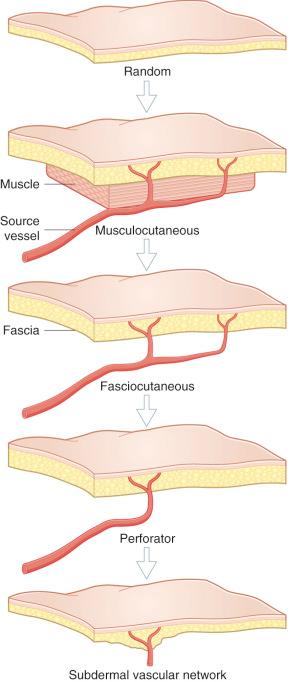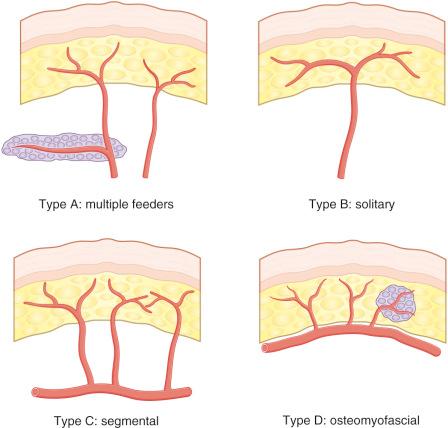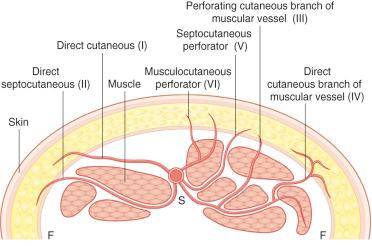Physical Address
304 North Cardinal St.
Dorchester Center, MA 02124
The history of plastic surgery is in many ways a recapitulation of the history and corresponding evolution of flaps ( Fig. 2.1 ). The earliest flaps were, as would be considered today, random skin flaps, as the skin was raised without regard to any known blood supply other than to maintain the presence of the subdermal vascular plexus. The classification of flaps in the beginning was relatively easy, since they could be distinguished from one another only according to how they were constructed. This included how they were transposed (e.g., as an advancement, rotation, or transposition flap), their geometrical configuration (e.g., as a tubed flap), or by their destination (e.g., as a local or distant flap). Because of their limited blood supply, there was a belief that random flaps had to be restricted to rigid length–width ratios to ensure viability. Still, some flaps lived and others died.

Such simplicity faded after Milton disproved flap length–width ratios, and asserted instead that flap viability was dependent on the vascular supply of the given flap territory. This led to a renaissance in flap construction, based on an improved understanding of the anatomic basis of the circulation to the skin, initiated by McGregor and Morgan, when they discovered that some regions of the body had discrete and relatively large subcutaneous vessels that had pierced the deep fascia to follow a predictable course. Comparatively large cutaneous flaps, if oriented along the axis of that vascular pathway, consistently maintained complete viability, and appropriately were called axial flaps (e.g., deltopectoral flap, groin flap).
Orticochea reported that the inclusion of muscle in the flap could result in larger skin flap survival. McCraw et al. more precisely explained the reasoning behind this association, and called the vessels coursing from the muscle to the skin “musculocutaneous” arteries. Interestingly, Tanzini in 1906 had published the first report of such a musculocutaneous flap. Tanzini et al., were well aware of the existence of branches from the muscle necessary to form these compound flaps. Nevertheless, it was not until the late 1970s that musculocutaneous flaps became a standard reconstructive option.
The zeal to adopt cutaneous flaps relying on musculocutaneous vessels perhaps delayed the recognition of other important contributions to the “fascial plexus” that would eventually allow cutaneous flaps to stand alone. Pontén deserves credit for reintroducing fasciocutaneous flaps, although he was not quite sure why the inclusion of the deep fascia with his “superflaps” resulted in a longer flap survival length than could be predicted for random flaps of comparable width. Note that Esser and Schwerer, and Gillies in the early part of the last century, had already suggested that it was advantageous to include the deep fascia with skin flaps, so that perhaps all along, this, too, was common knowledge.
The “fascial plexus” essential for survival of these fasciocutaneous flaps is not a discrete structure per se, but represents a confluence of subfascial, intrafascial, and suprafascial vascular plexuses within the dermal, subdermal, superficial adipofascial (above Scarpa's fascia), and deep adipofascial layers, where each is a component part of a magnificent array of interconnected vessels. The medical student Manchot, more than 100 years ago, was also well aware that “larger cutaneous arteries … appear from the fissure between … muscles …” as intermuscular or septocutaneous perforators of the deep fascia. These, along with the direct perforators of axial flaps and musculocutaneous perforators, are today the major contributors to the “fascial plexus” from the underlying source vessels of a given angiosome.
As microsurgical tissue transfer became widely adopted, there was an exponential growth in flap options. Virtually every tissue could then be transferred including muscle, bone, nerve, viscera, etc. As well, modifications and combinations such as perforator flaps, conjoined and chimeric flaps were reported leading to an explosive development in choices of flaps. The challenge was to classify all of these flaps into a system that allows teaching, research, and communication regarding flaps.
In the last few decades there have been many attempts to provide a modern classification schema for skin flaps. The simplest system is to describe all skin flaps as having direct cutaneous, septocutaneous, or musculocutaneous perforators. However, many authors have published other concepts of the vascular supply to skin flaps, which has led to some degree of confusion about the terms. In this section, we aim to clarify the terms used in the most well-known classifications.
Nakajima et al. (1986) separated skin flaps into five types: random pattern, fasciocutaneous, adipofascial, septocutaneous, and musculocutaneous flaps.
Cormack and Lamberty (1984) emphasized that the term “fasciocutaneous” implied retention of a system of vascularization within the given flap, and does not refer to any specific tissue constituents per se. Thus, even if the skin (e.g., adipofascial flap) and/or deep fascia (e.g., subcutaneous flap) are excluded from a flap that is dependent on the remaining “fascial plexus,” such a flap would still be a “fasciocutaneous” flap. A fasciocutaneous flap can be composed of any or all of the tissue layers found between the skin and deep fascia. By this definition, Cormack and Lamberty were further able to contract all skin flaps into a tripartite system that included direct cutaneous ( sic . axial), musculocutaneous , and fasciocutaneous flaps.
Cormack and Lamberty classified fasciocutaneous flaps into four major types ( Fig. 2.2 ), differentiated by the origin of the circulation to their “fascial plexus.” Their Type A flap had multiple “fascial feeders” or perforators that did not require specific identification, reminiscent of the random skin flap. Type B flaps contained a large, solitary septocutaneous perforator. The Type C flap relied on multiple and usually diminutive segmental septocutaneous branches, so that elevation of these flaps almost always necessitated inclusion of the source vessel with the flap, in order to maintain their complete integrity. Type D is similar to Type C in that it is based on multiple small perforators; however, it is raised as an osteomyofasciocutaneous flap.

Mathes and Nahai's (1997) classification of fasciocutaneous flaps based on the type of deep fascial perforator ( Fig. 2.3 ) is similar to Cormack and Lamberty's classification of flaps: their Type A is a direct cutaneous flap, in which the vascular pedicle travels deep to the fascia for a variable distance then pierces the fascia to supply the skin (e.g., groin flap, temporoparietal fascia flap). Type B is a septocutaneous flap, which has a vascular pedicle that courses within an intermuscular septum (e.g., lateral arm flap, radial forearm flap). Type C is a musculocutaneous flap and is based on a vascular pedicle that is traveling within the muscle substance (e.g., DIEP flap).

Nakajima et al. expanded the subtypes of fasciocutaneous flaps into six forms (Types I–VI, or A–F), each based on a distinctly different perforator of the deep fascia ( Fig. 2.4 ). Most had been previously described, e.g., their Type I “direct cutaneous flaps” were identical to the axial flaps of McGregor and Morgan. The Type II “direct septocutaneous flaps” were identical to Cormack and Lamberty's type B fasciocutaneous flaps, and the type V “septocutaneous perforator flaps” would be the same as the latter's Type C. The Type VI “musculocutaneous perforator flaps” resembled traditional myocutaneous flaps.

The remaining two types of flaps hypothesized by Nakajima et al., based on a “direct cutaneous branch of muscular vessel” (IV) and “perforating cutaneous branch of a muscular vessel” (III), were without question different and that is their most important contribution. Later, using computer graphics imaging, Nakajima et al ., in a 3-dimensional view of the “fascial plexus,” demonstrated that the axiality, vessel size, and suprafascial course of these vessels proved that the function of these “muscular vessels” was to provide nutrition to the skin, and only secondarily to the involved muscle. The “direct cutaneous branch of muscular vessel” remains an enigma due to its variable presence and has been little described. However, the “perforating cutaneous branch of muscular vessel” has become recognized as the basis for the perforator flaps. Some have argued that these are the only “true” perforator flaps.
The fasciocutaneous flap classification schemas of Cormack and Lamberty, Nakajima et al., and then Mathes and Nahai (see below) are very similar, as each uses subtle differences in circulation patterns to distinguish their flap subtypes. This is also a pragmatic approach, as the vascular supply, if nothing else, must be correctly identified and protected to ensure flap viability. Yet even further consolidation of cutaneous flap types is possible.
Become a Clinical Tree membership for Full access and enjoy Unlimited articles
If you are a member. Log in here